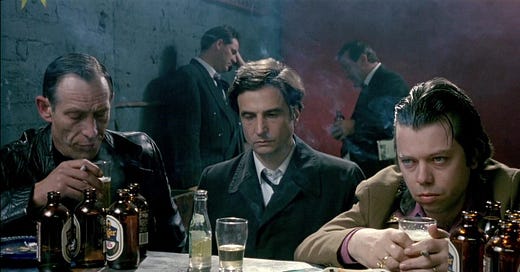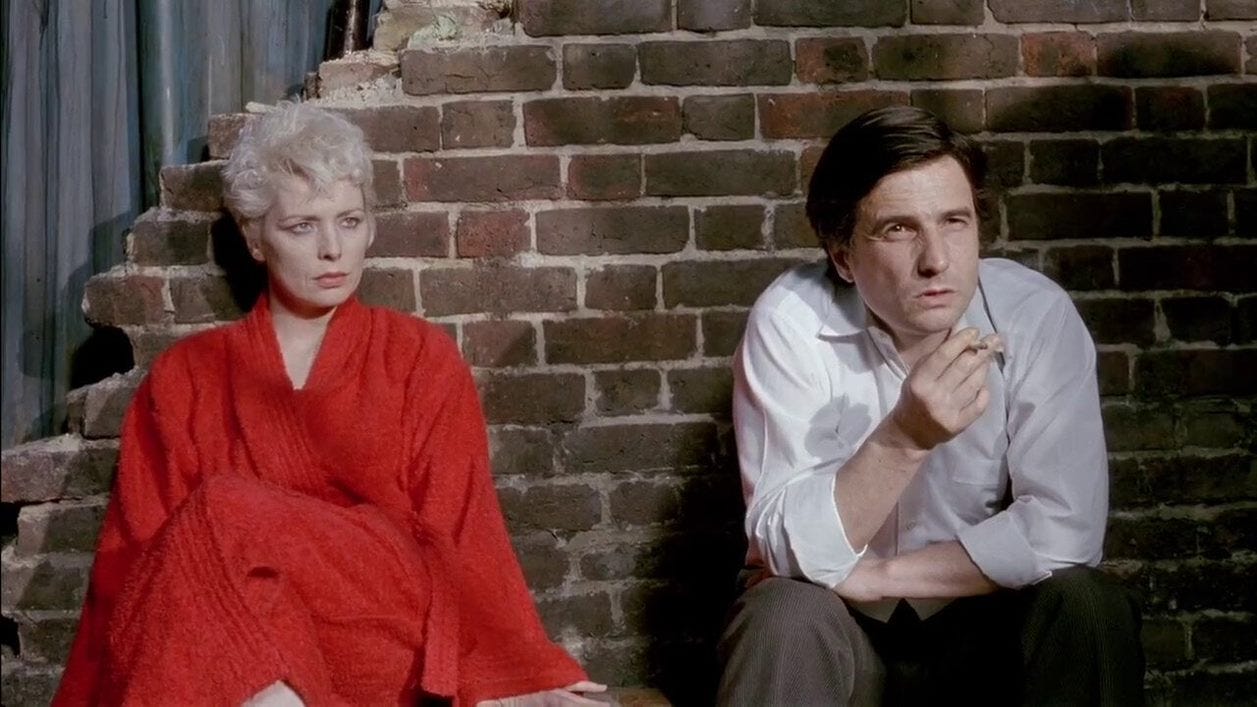Electric Theatre: I Hired a Contract Killer (1990)
Owen Vince follows a suicidal French clerk into the seedy underbelly of Aki Kaurismäki’s 'not London'
Electric Theatre is a rotating column where we invite some of our favourite people to write about London on film. It’s an opportunity to look at how the city has been represented on the big screen over the years, how its landmarks and structures have been used (and abused) and how various genres and directors extract wildly different performances from its streets.
For this instalment of Electric Theatre London-based writer and producer, Owen Vince descends into the “denuded fringes and hollowed-out centres” of Aki Kaurismäki’s London, via his1990 film, I Hired a Contract Killer.
Welcome to the Electric Theatre. Please turn off your phones and refrain from talking for the duration of the entertainment.
For an avowedly global city, London’s filmic image has long been squatted on by Patrick Keiller; whose London can feel like the first and last ‘word’ on the big smoke. It is a hyper-referenced time capsule – 1994, London through the eyes of a London-er. But London is gravitational. It has pulled all sorts of eyes toward its centre – and its fringes.
During the long flowering of the late 20th century, the world came to London – as did its filmmakers. There was Antonioni’s Blow-Up (1966), Polanski’s Repulsion (1965), Skolimowski’s Deep Red (1970), Lynch’s Elephant Man (1980) – the return of the imperial ‘periphery’ to its now sclerotic core. Erotics – the gory theatrics of violence and obsession. Here was the meeting place of Keiller’s ‘silly old England’ and its morbid, Dickensian underbelly; dialectically trapped between ‘keeping calm’ and freaking out. Mike Leigh hovers behind all of this, a high priest of elegiac grimness.
Enter I Hired a Contract Killer (1990) by Aki Kaurismäki – a film made by a Finnish director, shot in London, and recorded in the English language. It is – for want of a better word – an exogenous film: a film that is the product of an ‘outsider’ looking in.
And what it sees – this exogenous film – is not only the city (the city of London), but films of and about the city. Most importantly, it is dedicated to the memory of Michael Powell (alongside Emeric Pressberger, you’ll know him from The Red Shoes [1948]) – a fact announced in blood red type at its very beginning. This isn’t inconsequential. Powell typifies a particular vision of England – and of London – as a cinematic ‘text’ – bittersweet, eccentric, fantastical; served with a hint of the taboo. If Kaurismäki is laying his cards out, he’s also illuminating a kind of divergence – a paean to what is (or is about to be) lost. And with it, the gentle sparkling of Ealing comedies and gangster tragedies that are the real bread and butter of London’s cinema.
How – why? In brief (and it is very easy to swallow), Kaurismäki’s film centres on the anomic figure of Henri, a monosyllabic French clerk working at a lacklustre government office. Losing his job of fifteen years – a victim of privatisation and ever-familiar ‘efficiency’ savings – Henri decides to end his life. Suicide doesn’t work (his plyboard ceiling can’t support the weight of his body – while the gas goes off with his head still stuck in the oven).
Unbowed, he seeks out a group of gangsters, offering them £1,000 to hire a contract killer – with him as the target. In the course of the film, Henri meets Margaret – a Liverpudlian flower-seller – and has a change of heart, deciding to cancel his own hit job. Along the way, Henri discovers a certain jouissance among all the rot and decay. Now, roused by love – and by whisky, and cigarettes – he must fight to live. He must fight to live in London.
Journeys. Kaurismäki takes us from the Westway to Stoke Newington – from the Isle of Dogs to the Holborn viaduct. Like Keiller, he roves – veering axially along the escape trajectories of the city (they might also be thought of as drains). Like so many London films of this era – from the mid 60s to the late 80s – we’re obviously getting the city as a time capsule, before the Blairite boom; Cranbrook Point, Dunlop Tower (both now demolished). The many monoliths of the New London Vernacular have only subsequently shot up. Cranes arch above the city. Rot and grime – and only the barest handful of shop signs; none of which point toward chains or corporations.
Quite consciously: Kaurismäki is taking us on a joyride through London’s denuded fringes and hollowed-out centres; places that – even in his time – would soon be hollowly glowed up with gigantic advertising hoardings, CAD renderings, and luxury condominiums. For Claire Monk, Kaurismäki’s optics embodies a “transnational outsider representation of London”; asking that we pay heed to its cinematic geography. And what geography! Post-industrial, post-imperial – a grey, greige palette of rotting, boarded-up shop-fronts and piles of detritus. A city that is both rotting and re-making itself. What place for all these lonely clerks and flower sellers and gangsters? They too are being ground down (and out). Ultimately, the film’s contract killer – played by Kenneth Colley – takes his own life; bullet to the chest, dying yards only from Abney Wood cemetery. Killer, kill thyself.
Kaurismäki’s London is severed from time (like Henri’s watch – which is broken), while still being subject to the slow creep of decay. Of the city’s financial and business districts – which, in 1989 and 1990, would have been stuffed with high-tech computers and chromed-up financial instruments – Kaurismäki allows them to materialise only at the limit of his wide urban panning shots. Henri is not there. This other city belongs to smoke and mirrors; a spectre. The office of the soon-to-be privatised waterworks which employs him is dingy; positively Dickensian. Greasy walls, rotten sideboards, murky light – all accompanied by the clatter of typewriters and piles of paper (we’re verging on the Gogolian here). His flat is no different – a shabby garret on the now swanky Portobello Road.
In these scenes, Kaurismäki’s choice of music is pointedly intentional. For the first half of the film, it’s archaic – ill-fitting. The blues of Little Willie John and the vocal strains of Billy Holiday. Nothing contemporary, nothing new. Henri stalks an already lapsed historical moment. In this, there’s a strong parallel with Kaurismäki’s debut film, Crime and Punishment (1983) – another dislocated Dostoevskian fable.
Keep reading with a 7-day free trial
Subscribe to London in Bits to keep reading this post and get 7 days of free access to the full post archives.






